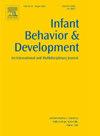Longitudinal study of early bite profiles as predictors of eating behaviors in children: Food responsiveness and emotional overeating
IF 2
3区 心理学
Q3 PSYCHOLOGY, DEVELOPMENTAL
引用次数: 0
Abstract
This study investigates eating profiles in toddlers, characterized by observed latency to first bite and bite frequency during naturalistic family mealtimes, and their predictive value for parent-reported food responsiveness and emotional overeating. The sample included 109 children and their families participating in a longitudinal birth cohort study in the United States. Video-recorded family mealtimes at 18–24 months were systematically coded for latency to first bite and bite speed. Food responsiveness and emotional overeating were measured using the Child Eating Behavior Questionnaire at 36 months. Latent Profile Analysis using Gaussian finite mixture modeling identified three profiles labeled as fast-initiating, slow eaters; slow-initiating, slow eaters; and fast-initiating, fast eaters. Linear regression revealed that early bite profiles predict food responsiveness and emotional overeating at 36 months. Slow-initiating, slow eaters exhibited significantly higher food responsiveness than fast-initiating, slow eaters, while fast-initiating, fast eaters and slow-initiating, slow eaters had significantly higher emotional overeating than fast-initiating, slow eaters. These findings highlight the potential for early interventions targeting children’s bite profiles to identify those at higher risk for dysregulated eating behaviors, thereby promoting healthier eating patterns.
儿童饮食行为预测因素的早期咬痕特征的纵向研究:食物反应和情绪性暴饮暴食
本研究调查了幼儿的饮食特征,其特征是在自然的家庭用餐时间观察到第一次咬的潜伏期和咬的频率,以及它们对父母报告的食物反应和情绪性暴饮暴食的预测价值。样本包括109名儿童及其家庭,他们参加了美国的一项纵向出生队列研究。录像18-24个月的家庭用餐时间,系统地编码第一次咬的潜伏期和咬速。在36个月时使用儿童饮食行为问卷测量食物反应性和情绪性暴饮暴食。使用高斯有限混合模型的潜在剖面分析确定了三种快速启动,缓慢进食的剖面;行动迟缓,吃得慢;和快速启动,快速食客。线性回归显示,早期的咬痕特征可以预测36个月时的食物反应和情绪性暴饮暴食。慢启动、慢启动的人比快启动、慢启动的人表现出更高的食物反应性,而快启动、快启动和慢启动、慢启动的人比快启动、慢启动的人表现出更高的情绪性暴饮暴食。这些发现强调了针对儿童咬痕特征进行早期干预的潜力,以识别那些饮食行为失调的高风险人群,从而促进更健康的饮食模式。
本文章由计算机程序翻译,如有差异,请以英文原文为准。
求助全文
约1分钟内获得全文
求助全文
来源期刊

Infant Behavior & Development
PSYCHOLOGY, DEVELOPMENTAL-
CiteScore
4.10
自引率
4.80%
发文量
94
期刊介绍:
Infant Behavior & Development publishes empirical (fundamental and clinical), theoretical, methodological and review papers. Brief reports dealing with behavioral development during infancy (up to 3 years) will also be considered. Papers of an inter- and multidisciplinary nature, for example neuroscience, non-linear dynamics and modelling approaches, are particularly encouraged. Areas covered by the journal include cognitive development, emotional development, perception, perception-action coupling, motor development and socialisation.
 求助内容:
求助内容: 应助结果提醒方式:
应助结果提醒方式:


